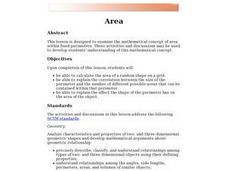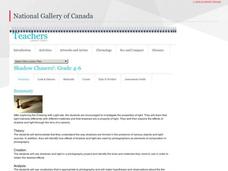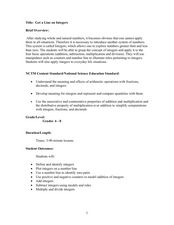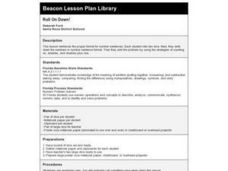Curated OER
Ants
Students make sequential patterns by using ants and following the model. They identify different parts of an ant by matching the picture to the word name. Pupils identify the ant's life cycle by creating a chart using pictures.
Curated OER
Fractions
Students observe and demonstrate a variety of activities to identify the fraction parts and the symbols they represent. As a class they explore different fractions using unifix cubes, then use the cubes to build and discuss the...
Curated OER
Eatem Up!
Students identify, interpret and demonstrate a positive learning attitude. They identify, comprehend and use basic concepts and skills and then, communicate clearly in oral, artistic, written, and nonverbal form. Students also identify...
Fuel the Brain
Counting Money
How much money do the children in these word problems have? Through addition and subtraction with the help of visual representations drawn by your pupils, they will understand these skills better.
Curated OER
Modeling the Keeling Curve with Excel
For this modeling the Keeling Curve worksheet, students use given data beginning in 1960 to create a mathematical model for the changes in atmospheric carbon dioxide over time. Students manipulate the equation to predict the carbon...
Curated OER
Reviewing Facts Through 10
Manipulatives are always fun for children to use. They use connecting cubes and blocks to solve addition and subtraction word problems with numbers up to 10. They then play a math game and use their cube to create number sentences....
Curated OER
How the West Was One - Three x Four
While this activity provides a motivating and interesting way to review the concept of the order of operations, it involves the use of software called How the West Was One + Three x Four. There are also other resources that are...
Curated OER
Dissecting Frog Embryos: Cell Membranes and Mitosis
Students use high powered dissection microscopes to dissect and examine frog embryos as well as see balls of cells that were produced by rapid division. The concept of mitosis links to the lesson.
Curated OER
Area Applet
Elementary math classes calculate the area of a shape and explain the correlation between the size of the perimeter and the areas that can be contained within that perimeter. They also explain the effect the shape of the perimeter has on...
Inside Mathematics
Marble Game
Pupils determine the theoretical probability of winning a game of marbles. Individuals compare the theoretical probability to experimental probability for the same game. They continue on to compare two different probability games.
National Gallery of Canada
Shadow Chasers!
Experiment with light and shadow with a photography lesson. Learners first view several artistic photographs. They then play with different levels of light and various objects, eventually putting together compositions and taking pictures...
Virginia Department of Education
Modeling Division of Fractions
Provide a meaningful context for learning about the division of fractions with this upper-elementary math lesson plan. Presented with a simple, real-world problem, young mathematicians work in small groups to develop visual...
PACER Center
The Peer Advocacy Guide
Teasing, mocking, and disrespect can be the hallmarks in the life of those with disabilities. Disrupt the cycle of abuse with a toolkit designed to turn peers into advocates for all those who are bullied. Everything needed to create a...
Curated OER
Problem Posing Mathematics
Students work on multiplication problems. In this hands-on math instructional activity, students practice the concept of multiplication through manipulatives, arrays, pictures, and drawings. They discover other ways of learning...
Curated OER
Operations of Polynomials
Students investigate the concept of manipulating polynomials. They go through the process of using algebra tiles in order to practice grouping of like terms and model the solving process.
Curated OER
1st Grade Problem Solvers
First graders investigate, represent and solve problems using number facts, operations, and their properties. They solve on-step addition and subtraction number sentences and word problems using concrete materials. Students construct...
Curated OER
Get a Line on Integers
Middle schoolers explore number sense by completing math function problems in class. In this integers lesson, students define integers and practice plotting them on a number line. Middle schoolers utilize math functions such as addition...
Curated OER
Multiplication Illustration
Third graders use literature and art to apply the principals of multiplication with three or more factors. They write and illustrate their own books following criteria outlined in a checklist imbedded in this plan.
Curated OER
Unit 2 Sun & Stars
Students describe stellar objects using terms such as stars, planets, satellites, orbits and light. In this sun and stars unit, students research stellar objects through seven individual lessons discovering star characteristics, how...
Curated OER
Roll On Down!
Students create number sentences by rolling two dice. Each student rolls the dice and writes down the numbers in number sentence format. Then they add the problem by using the strategies of counting on and doubles.
Curated OER
1st Grade Math: Greater Than, Less Than
First graders participate in a variety of math activities that emphasize the concepts of greater than, less than, and equal to. They order numbers on the number line, compare numbers, create letters using numbers on a 1-100 number chart,...
Curated OER
Jack Math Scramble
Students practice throwing and catching jacks to improve their hand-eye coordination. In groups, they participate in a variety of games in which they use the jacks to improve their problem solving skills. To end the lesson, they pick up...
Curated OER
Fractions of a Band
Third graders investigate fractions. In this time lesson, 3rd graders determine the amount of time it takes to perform certain tasks.
Curated OER
Math Jeopardy
Young scholars write questions for a Jeopardy game. In this integer review lesson, students review integers by navigating through a linked web site. They play a Jeopardy game. Young scholars create five questions, one for each of the...























